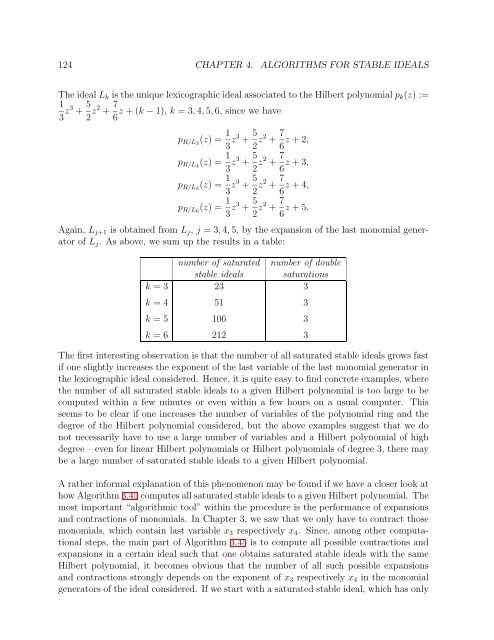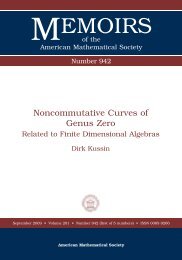University of Paderborn Department of Mathematics Diploma Thesis ...
University of Paderborn Department of Mathematics Diploma Thesis ...
University of Paderborn Department of Mathematics Diploma Thesis ...
You also want an ePaper? Increase the reach of your titles
YUMPU automatically turns print PDFs into web optimized ePapers that Google loves.
124 CHAPTER 4. ALGORITHMS FOR STABLE IDEALSThe ideal L k is the unique lexicographic ideal associated to the Hilbert polynomial p k (z) :=13 z3 + 5 2 z2 + 7 z + (k − 1), k = 3, 4, 5, 6, since we have6p R/L3 (z) = 1 3 z3 + 5 2 z2 + 7 6 z + 2,p R/L4 (z) = 1 3 z3 + 5 2 z2 + 7 6 z + 3,p R/L5 (z) = 1 3 z3 + 5 2 z2 + 7 6 z + 4,p R/L6 (z) = 1 3 z3 + 5 2 z2 + 7 6 z + 5.Again, L j+1 is obtained from L j , j = 3, 4, 5, by the expansion <strong>of</strong> the last monomial generator<strong>of</strong> L j . As above, we sum up the results in a table:number <strong>of</strong> saturated number <strong>of</strong> doublestable ideals saturationsk = 3 23 3k = 4 51 3k = 5 106 3k = 6 212 3The first interesting observation is that the number <strong>of</strong> all saturated stable ideals grows fastif one slightly increases the exponent <strong>of</strong> the last variable <strong>of</strong> the last monomial generator inthe lexicographic ideal considered. Hence, it is quite easy to find concrete examples, wherethe number <strong>of</strong> all saturated stable ideals to a given Hilbert polynomial is too large to becomputed within a few minutes or even within a few hours on a usual computer. Thisseems to be clear if one increases the number <strong>of</strong> variables <strong>of</strong> the polynomial ring and thedegree <strong>of</strong> the Hilbert polynomial considered, but the above examples suggest that we donot necessarily have to use a large number <strong>of</strong> variables and a Hilbert polynomial <strong>of</strong> highdegree – even for linear Hilbert polynomials or Hilbert polynomials <strong>of</strong> degree 3, there maybe a large number <strong>of</strong> saturated stable ideals to a given Hilbert polynomial.A rather informal explanation <strong>of</strong> this phenomenon may be found if we have a closer look athow Algorithm 3.45 computes all saturated stable ideals to a given Hilbert polynomial. Themost important “algorithmic tool” within the procedure is the performance <strong>of</strong> expansionsand contractions <strong>of</strong> monomials. In Chapter 3, we saw that we only have to contract thosemonomials, which contain last variable x 3 respectively x 4 . Since, among other computationalsteps, the main part <strong>of</strong> Algorithm 3.45 is to compute all possible contractions andexpansions in a certain ideal such that one obtains saturated stable ideals with the sameHilbert polynomial, it becomes obvious that the number <strong>of</strong> all such possible expansionsand contractions strongly depends on the exponent <strong>of</strong> x 3 respectively x 4 in the monomialgenerators <strong>of</strong> the ideal considered. If we start with a saturated stable ideal, which has only
















